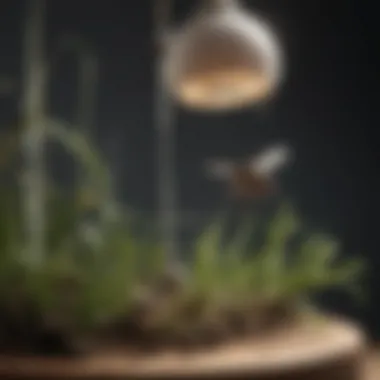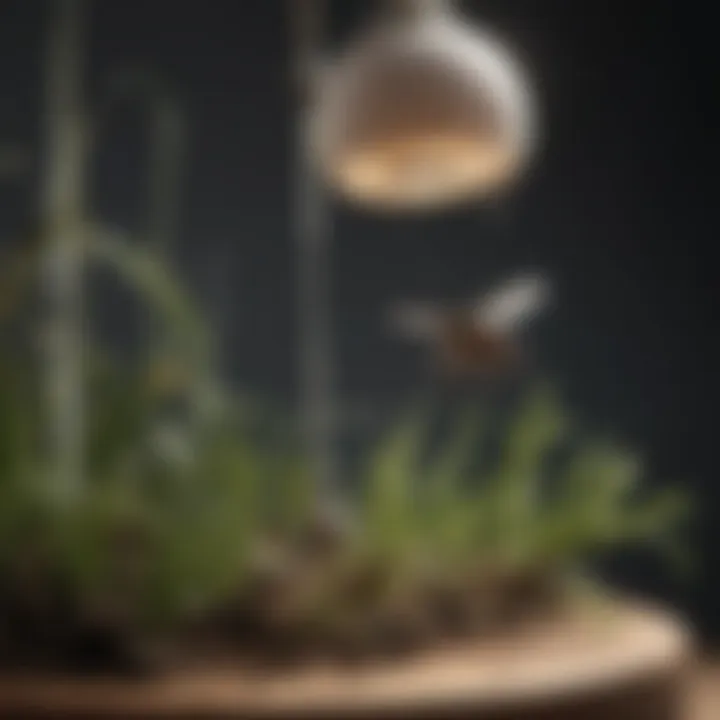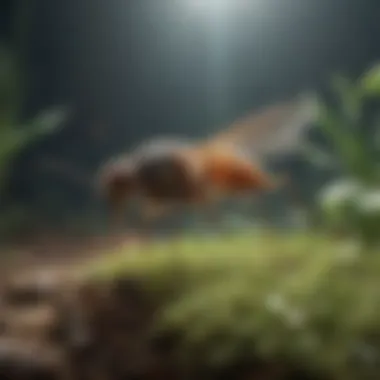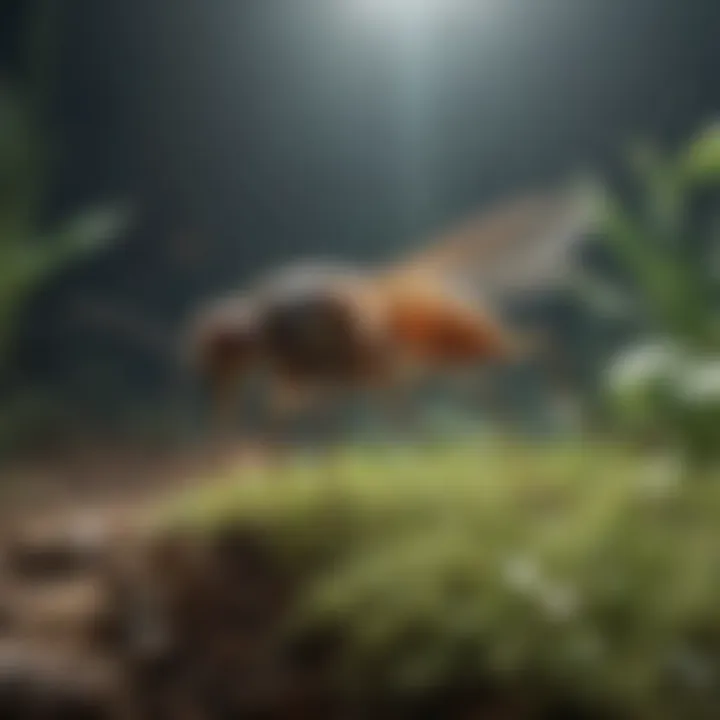The Gnat Fly Trap: Identification and Management Guide


Intro
Gnat fly traps play an important role in managing pest populations effectively. These devices are essential for anyone who has experienced the nuisance of gnats, whether at home or in outdoor spaces. Understanding their functionality, types, and overall effectiveness can significantly impact how you control these pests.
The article aims to bridge knowledge gaps regarding the biological aspects of gnats and how traps serve as a critical tool in prevention. It will also highlight common misconceptions surrounding traps, providing practical advice on their use. By the end, you will have a clearer understanding of how to wield traps as an effective component in your pest management strategy.
Design Inspirations
While one may not directly associate style with pest control devices, the aesthetics of gnat fly traps can be surprisingly important, especially for homeowners and garden enthusiasts. A well-designed gnat trap can fit seamlessly into your home or garden environment.
Trending Styles
Current designs cater to needs beyond mere functionality. Many traps now incorporate sleek lines and neutral colors, easily blending with existing decor. This trend is particularly suitable for indoor traps, where visibility can be a concern. Here are some styles to consider:
- Classic glass jars: These traps are both functional and aesthetically pleasing, often seen in contemporary kitchen settings.
- Decorative lanterns: Popular for outdoor use, these traps can add charm while effectively luring gnats.
- Minimalistic designs: These traps often emphasize simplicity, maintaining a clean look.
Color Palettes
The color of your gnat trap can also influence its effectiveness. Darker colors can draw more gnats, while brighter colors tend to attract attention in outdoor settings. When choosing a trap, consider the following options:
- Dark hues: Such as black or deep green, work well in attracting pests and blending into garden landscapes.
- Bright colors: Like yellow or light blue, can make traps more visible, ensuring they are not overlooked.
In your selection process, keep your current indoor or outdoor aesthetic in mind, ensuring both functionality and design go hand in hand.
Maintenance and Upkeep
Maintaining gnat fly traps is critical for maximizing their effectiveness. Regular upkeep ensures traps continue to perform well and remain an integral part of your pest management strategy.
Seasonal Maintenance Checklist
- Inspect traps regularly: Look for any wear and tear that might hinder effectiveness.
- Replace bait as needed: Fresh bait can attract more gnats.
- Clean the traps: Residue buildup can reduce catch efficiency.
Cleaning and Organization Tips
- Keep traps in designated areas, making them easy to access for routine maintenance.
- Use simple solutions like soap and water for cleaning, avoiding harsh chemicals that could deter gnats.
- Organize your traps by type, ensuring easier identification and management.
Maintaining gnat fly traps makes them more effective, preventing infestations before they start. Regular attention can save you from larger pest problems down the line.
Understanding Gnats
Understanding gnats is crucial for effective pest management. Gnats can be more than just a nuisance; they can indicate underlying issues in your environment. This section will provide insight into their behavior, types, and life cycle. Such knowledge equips homeowners and gardening enthusiasts to adopt the most suitable control strategies and maintain a more pleasant living and growing space.
Biology and Behavior
Gnats are tiny flying insects, often mistaken for fruit flies. Their size generally measures around one to five millimeters. While they can be found in various colors, many species exhibit a greyish or black hue. The biology of gnats plays a critical role in understanding how to control them effectively. They thrive in moist environments which is why they are often found near plants or in kitchens. Gnats prefer to lay eggs in damp soil or overripe fruit, creating new generations rapidly.
Behaviorally, gnats are attracted to decaying organic matter and moist areas. They contribute to the decomposition process in nature, but their presence in homes can be quite the opposite. Familiarizing oneself with their behavior helps in identifying the reasons for infestations.
Types of Gnats
The species of gnats vary considerably, and acknowledging their differences can enhance management strategies. Here are four notable types:
Fungus Gnats
Fungus gnats are common in potting soil. They thrive in damp conditions and can become a problem for indoor plants. Their larvae can damage plant roots, creating a significant concern for indoor gardening enthusiasts. Recognizing fungus gnats is essential since their appearance often signals overwatering or inadequate drainage in pots. Their small size and tendency to swarm near the soil surface make them troublesome.
Fruit Flies
Fruit flies, often found around overripe or rotting fruit, are drawn to fermentation scents. They can reproduce quickly, emphasizing the need for prompt action if they invade your space. What makes fruit flies particularly notable is their association with food spoilage, indicating poor storage or cleanliness. They are very common in kitchens, and their presence can be a signal to homeowners to maintain tidier environments.
Drain Flies
Drain flies inhabit sink drains and sewer areas. Similarly to fungus gnats, they lay eggs in decaying organic matter. Their unique feature here is their fuzzy appearance, which can make them distinguishable from other types. Drain flies often indicate plumbing issues such as clogged drains or stagnant water, which should be addressed to prevent future infestations. Understanding them allows for direct targetting of the source of infestation.
Black Gnats
Black gnats are typically found outdoors, especially near bodies of water or damp areas. They are known for their relentless buzzing and can become an annoyance during outdoor gatherings. Unlike other gnats, their bites can be painful, contributing to their negative reputation. Recognizing black gnats helps outdoor enthusiasts prepare with preventive measures whenever they enjoy their outdoor spaces.


Life Cycle of Gnats
Understanding the life cycle of gnats is imperative for determining their management. This cycle consists of four stages that allow rapid population growth: the egg stage, lava stage, pupal stage, and adult stage. Knowledge of this cycle supports targeted strategies aimed at disrupting it.
Egg Stage
In the egg stage, female gnats lay numerous eggs in moist areas, such as soil or decaying organic matter. Recognizing this stage is crucial because where eggs are laid can indicate where the problem may be centered. Controlling moisture and cleanliness can help manage this stage effectively.
Lava Stage
The larvae emerge from the eggs and continue to develop in similar moist environments. At this stage, they are more destructive to plants and resources. Their ability to adapt makes it important for homeowners to take action as soon as possible when they identify a problem.
Pupal Stage
Pupae are a transition phase for gnats. They can remain inactive for a period, which means issues may persist even when adult gnats are unseen. Recognizing that the pupal stage exists allows for understanding why some control measures may require time to show effects.
Adult Stage
Adults emerge from the pupae, leading to another round of potential infestation. They can reproduce quickly, so addressing adults swiftly is vital. Recognizing their habits can assist in knowing how to manage existing populations effectively.
The Concept of Gnat Fly Traps
Understanding the concept of gnat fly traps is vital for anyone interested in effective pest management. These traps provide an essential method for reducing gnat populations, which can become a nuisance both indoors and outdoors. As simple as they may seem, gnat fly traps serve critical functions, from attracting these pests to capturing them efficiently. Grasping their intricacies allows homeowners, gardening enthusiasts, and party hosts to select the right trap type and ensure optimal placement.
What Are Gnat Fly Traps?
Gnat fly traps are specialized tools designed to catch and control gnat populations. They come in various forms and materials, primarily creating an environment that lures gnats toward them. Generally, these traps are crafted from non-toxic substances, ensuring safety in homes and gardens. Their function encompasses several components:
- Attraction Mechanisms: Many traps utilize lures, scents, or visual cues to attract gnats, enhancing their effectiveness.
- Capture Methods: Once attracted, gnats meet various capture mechanisms, ensuring they cannot escape. Some traps rely on sticky surfaces, while others may use liquid to drown the pests.
- Placement Versatility: Gnat fly traps can be deployed in various settings, ranging from kitchen counters to garden beds, allowing flexibility depending on identified gnat sources.
Essentially, gnat fly traps are not mere pest control gadgets; they embody a strategic approach towards managing gnat-related issues in diverse environments.
How Gnat Fly Traps Work
The working principle of gnat fly traps is both straightforward and effective. Understanding this can empower users to utilize them correctly and efficiently. The operation can be broken down into a series of steps:
- Attraction: At the core of every gnat fly trap is its ability to attract pests. For example, sticky traps often use bright colors and sweet scents to draw gnats.
- Capture: Once drawn to the trap, gnats become ensnared. In sticky traps, they adhere to the surface, while liquid traps ensure they drown upon contact.
- Monitoring: Regularly checking the traps allows individuals to evaluate gnat populations. Keeping records can help track overall effectiveness over time.
Utilizing gnat fly traps effectively involves recognizing their mechanics. It is crucial to place them in high-traffic areas for gnats to maximize their potential.
"A well-placed gnat fly trap can reduce pest problems significantly, leading to a more pleasant environment."
In summary, gnat fly traps are indispensable in controlling gnat populations. Their attractive designs and effective capture methods make them essential tools for anyone facing gnat infestations.
Types of Gnat Fly Traps
Gnat fly traps are essential tools in the management of these persistent pests. Understanding different types of traps allows homeowners and garden enthusiasts to choose the most effective solutions for their specific gnat problems. Each trap type has its own benefits, features, and considerations when selecting the right option for effective gnat control.
Sticky Traps
Sticky traps are among the simplest and most widely used types of gnat fly traps. These traps are coated with a strong adhesive that captures gnats upon contact. One of the main benefits of sticky traps is their straightforward design and ease of use. They are often available in various shapes and sizes, allowing for placement in different environments, such as homes, offices, or greenhouse settings.
A key characteristic of sticky traps is their passive operation. They do not require any bait; instead, they rely on the natural attraction of light and scent to draw gnats towards the sticky surface. However, one consideration is the need for regular monitoring. Users should replace traps when they become too covered with pests to maintain effectiveness and keep the area visually appealing.
Liquid Traps
Liquid traps function differently than sticky traps. These traps typically use a liquid bait that entices gnats. Once they land on or fall into the solution, they become trapped in the liquid. The liquid often contains ingredients like vinegar or sugar, which serve as lures. A benefit of liquid traps is their ability to capture multiple gnats at a time, making them effective for larger infestations.
However, users must be cautious with placement. Ensuring the trap is not easily accessible to children or pets is critical. Additionally, users need to regularly check and refill the liquid bait to maintain its attractiveness and effectiveness.
DIY Traps
Many people opt for DIY traps as a cost-effective and easy way to manage gnats. The following subtypes of DIY traps are popular and effective in controlling these pests:
Vinegar Solutions
Vinegar solutions are known for their straightforward preparation and effectiveness in attracting gnats. The primary ingredient, vinegar, is highly appealing to many gnat species. Users can create a vinegar trap by mixing apple cider vinegar with a few drops of dish soap in a container. The vinegar attracts the gnats, and the dish soap reduces the surface tension, causing them to sink and effectively trapping them.


A key characteristic of vinegar solutions is their availability and low cost. This simplicity makes it a beneficial choice for those seeking easy solutions. However, one unique feature is that the effectiveness depends on the type of vinegar used; some may work better than others depending on local gnat species. Another point to consider is that while these traps can attract many gnats, they may not capture all; thus, combining with other traps may enhance outcomes.
Soap and Water Traps
Soap and water traps are another popular DIY method for gnat control. This trap involves mixing water with a small amount of liquid soap, which acts as a sundent. When gnats come in contact with the soapy water, they struggle to escape and ultimately drown.
The key characteristic of soap and water traps is their ease of setup. Users can create them using common kitchen ingredients and containers. Like vinegar traps, these traps are beneficial because they utilize items readily available at home, providing an economical solution. However, soap and water traps may require frequent maintenance, as they can fill up with insects and debris. Regularly refreshing the solution helps maintain its effectiveness.
In summary, selecting a gnat fly trap requires understanding the advantages and limitations of each type. Whether using commercial options or DIY solutions, knowing how to use these traps effectively makes pest management simpler.
Effectiveness of Gnat Fly Traps
The effectiveness of gnat fly traps is vital in the broader context of pest management. Understanding how effective these traps can be ensures homeowners and enthusiasts can select the right tools and methods for their specific needs. Effective traps do not only catch gnats but also help manage populations, reduce infestations, and protect our living environments. It's essential to evaluate not only which traps to employ but also how they function in various settings. This evaluation allows users to make informed decisions that lead to better pest management outcomes.
Evaluating Trap Efficiency
When assessing the efficiency of gnat fly traps, several criteria come into play. First, one must consider the trap type itself. For instance, sticky traps often provide immediate results as they catch gnats on contact. They can be strategically placed in areas where gnats are prevalent. However, their effectiveness may diminish over time as they become covered in dirt or dust. On the other hand, liquid traps, which attract gnats with a bait solution, may take longer to show results but can capture larger numbers over time.
Equally important is the positioning of the traps. A trap placed in a high-traffic gnat area will yield better results than a trap in a seldom-used corner. Homeowners should also monitor the quantity and type of gnats captured. This tracking helps determine whether the particular trap is suitable for the intended environment.
In evaluating efficiency, consider the price point in relation to the provided benefits. Some traps may seem costly, yet if they significantly reduce gnat numbers, they present a worthy investment.
Factors Influencing Effectiveness
Numerous factors can influence the effectiveness of gnat fly traps:
- Type of Gnat: Different gnat species may respond differently to traps. For instance, fruit flies may be attracted to specific scents not appealing to fungus gnats.
- Environmental Conditions: High humidity or warmth can enhance trap performance. Conversely, cold temperatures might slow down the activity of both the gnats and the traps.
- Bait Utilization: The bait used plays a critical role in enticing gnats. Natural baits, such as apple cider vinegar, can attract gnats effectively. However, it is important to remember that the bait must be replaced regularly to maintain its effectiveness.
- Trap Maintenance: Regular maintenance, including cleaning and checking for effectiveness, is necessary. A neglected trap can become less efficient over time.
Other considerations might include placement strategies and compatibility with surrounding decor for homeowners focused on aesthetics. Emphasizing the importance of these factors enables better control and management of gnat populations.
Placement Strategies for Traps
Effective placement of gnat fly traps is crucial for their performance. Not only does the right placement enhance the traps' ability to catch gnats, but it also ensures a more effective overall pest management strategy. Understanding where these pests are most likely to appear allows homeowners and other users to significantly increase their success in controlling gnat populations. When traps are optimally placed, they can target the highest concentrations of gnats, leading to better outcomes.
Indoor Placement Recommendations
When considering indoor trap placement, it is beneficial to focus on areas with higher humidity and organic material presence. Here are some recommendations:
- Near Plants: Place traps close to houseplants, especially those that are overwatered, as this attracts fungus gnats.
- Kitchen Areas: Set up traps in and around the kitchen to catch fruit flies, especially near ripe fruits, trash bins, and recycling containers.
- Bathrooms: Position traps in bathrooms where moisture can encourage gnat presence. Look for places near sinks and drains.
- Dining Areas: Keep traps near dining tables or food prep areas, where food remnants can attract gnats.
By considering these strategic placements, users can maximize the efficiency of their traps and reduce the annoyance caused by gnats indoors.
Outdoor Placement Recommendations
For outdoor settings, effective trap placement must consider environmental factors that lure gnats. Here are some suggestions:
- Garden Areas: Position traps throughout gardens, particularly near compost piles or decaying vegetation.
- Patios and Decks: Place traps on patios or decks where food is often consumed, attracting fruit flies.
- Near Water Sources: Set traps around fountains or ponds, as moisture can lead to increased gnat activity.
- Trash Bins: Ensure traps are placed around outdoor trash cans to capture any gnats attracted by organic waste.
Employing these placement strategies can effectively control gnat populations and lead to a more pleasant outdoor environment.
Common Misconceptions About Gnat Fly Traps
Understanding common misconceptions about gnat fly traps is crucial for effective pest management. Many individuals believe that simply placing a trap will eradicate all gnat issues. However, this is an oversimplified view. Traps serve as one element within a broader pest control strategy. Misconceptions can lead to frustration and ineffective management. Therefore, it is vital to clarify these points to equip homeowners and gardening aficionados with the knowledge they need.
Are All Traps Created Equal?
Not all gnat fly traps exhibit the same level of effectiveness due to variations in design and function. For instance, sticky traps, while popular, may not capture all gnat species effectively. Some traps are designed specifically for certain types, such as fungus gnats or fruit flies. These specialized options often contain attractants or scents that appeal to particular gnat types.
When evaluating traps, consider factors such as:
- Attractants: Some traps utilize scents that are more appealing to different gnat species.
- Shape and Size: Certain traps are engineered for maximum capture based on gnat behavior.
- Material Quality: The durability and adhesiveness can vary greatly among brands.
To maximize effectiveness, homeowners should choose traps that target the specific gnat type present in their environment. This ensures better pest control and minimizes the number of gnats that escape capture.
Limitations of Traps
Gnat fly traps, while beneficial, are not without limitations. Numerous factors can hinder their efficiency in controlling gnat populations. Recognizing these limitations helps set realistic expectations.


Potential limitations include:
- Capacity Constraints: Most traps have a finite capacity. Once full, their effectiveness diminishes.
- Limited Range: Traps do not replace thorough cleaning or other preventive measures. They only capture gnats that come into contact with them.
- Environmental Influences: Traps can be less effective in poorly ventilated areas or in places with high infestations, where the number of gnats can exceed capture capacity.
Maintenance of Gnat Fly Traps
Proper maintenance of gnat fly traps is critical in ensuring their effectiveness. Regular upkeep not only enhances the traps’ ability to catch gnats but also prevents them from becoming breeding grounds for these pests. Maintaining these traps involves monitoring their condition and effectiveness over time.
Regular maintenance brings numerous benefits. First, it allows you to stay ahead of any potential gnat infestations by ensuring the traps are always operational. Second, it increases the lifespan of the traps, which saves you money in the long run. Third, proper maintenance minimizes the risk of other insects becoming attracted to the traps.
Regular Monitoring
Monitoring is a fundamental aspect of maintaining gnat fly traps. It involves checking traps frequently to assess their effectiveness and condition. Depending on the type of the trap, monitoring should occur every few days, especially in the initial stages of use. This close observation helps you to determine whether the traps are catching gnats and how many have been collected.
During monitoring, observe the following:
- Catch Rate: Noticing how many gnats are trapped will indicate the level of infestation. A decreasing number over time shows effective trapping.
- Trap Condition: Ensure that the traps do not have any damages and that the attractants are still effective. If they have become overly dirty or dry, they may need to be cleaned or replaced.
Successful gnat control requires proactive monitoring. Ignoring this step can lead to an overwhelming infestation.
Replacing Traps
Replacing traps is an essential part of maintenance that should not be overlooked. As the traps collect gnats and their attractants degrade, they become less effective. Depending on the specific type of trap, the frequency of replacement may vary. For sticky traps, a general rule is to replace them every 2-4 weeks or when they become saturated. Liquid traps may need to be replaced more frequently if they fill up quickly or change odor.
Key considerations for replacing traps include:
- Performance Decline: If the catch rate hits a plateau or decreases, it might be time for a new trap.
- Wear and Tear: Traps that are physically damaged or warped from exposure should be replaced to maintain optimal function.
- Attractant Freshness: Ensure that any bait or lures in traps are fresh and effective. Old or rancid attractants can deter gnats rather than attract them.
Alternative Gnat Control Methods
In the quest for effective pest management, alternative gnat control methods play a vital role. Relying solely on gnat fly traps may not be sufficient for comprehensive gnat management. Understanding the strengths and limitations of these alternatives can enhance overall effectiveness in controlling gnats. This section will explore two critical categories: natural remedies and chemical controls. Each alternative offers unique benefits and considerations that homeowners and gardening enthusiasts should evaluate carefully.
Natural Remedies
Natural remedies for gnat control are favorable for those looking to manage their pest issue without harsh chemicals. These methods often utilize common household items that can repel or eliminate gnats effectively. One popular solution involves using essential oils. Oils like lavender, peppermint, and eucalyptus not only have pleasant aromas but also possess insect-repelling properties. To create a simple spray, mix a few drops of essential oil with water in a spray bottle and apply it around affected areas.
Another effective natural remedy is the use of sticky traps. While this may seem similar to conventional fly traps, you can make these at home using materials like yellow paper coated with petroleum jelly. Setting them up where gnats are prevalent can catch them without the need for chemicals.
Consider the following natural remedies:
- Essential oils - Effective choices include lavender, peppermint, and citronella.
- Apple cider vinegar - A mixture can attract and trap gnats when placed in a bowl covered with plastic wrap.
- Baking soda and vinegar - A combination can help eliminate breeding sites in clogged drains.
While natural remedies are less toxic, they may not always provide immediate results. Patience and persistence are key when implementing these tactics.
Chemical Controls
Chemical controls represent a more aggressive approach to managing gnat populations. Homeowners who face persistent problems might find that these methods provide quicker and more pronounced results. Commercial insecticides are available in various formulations, such as sprays and granules. When selecting a product, it is crucial to opt for formulations specifically designed to target gnats.
The underlying mechanism of chemical controls typically involves disrupting the gnat’s life cycle or directly impacting their nervous systems. For example, pyrethrins are a common active ingredient found in many insecticides. They are derived from chrysanthemum flowers and are effective against various flying insects. When using chemical controls, always adhere to the instructions provided by the manufacturer to ensure safety and efficacy.
Key considerations when using chemical controls include:
- Targeted application - Apply chemicals primarily in areas where gnats congregate, such as the kitchen, garbage areas, or garden beds.
- Safety measures - Utilize personal protective equipment when applying insecticides to avoid potential adverse effects.
- Environmental impact - Be aware of the chemicals’ effects on beneficial insects and the overall ecosystem.
Chemical methods can serve as a robust complement to natural techniques, especially during severe infestations. However, moderation and responsible usage are paramount to prevent resistance development in pest populations.
When choosing between natural remedies and chemical controls, it ultimately depends on the severity of the gnat issue and personal preferences. An informed approach combining elements from both categories may yield the best results for effective gnat management.
Culmination
In summarizing the significance of gnat fly traps, it is essential to address several key elements related to their usefulness in pest management. This article has provided a thorough investigation into the biology of gnats, the variety of traps available, and the best practices for using and maintaining them. By employing gnat fly traps, individuals can create more pleasant living and working environments, effectively reducing the nuisance caused by these persistent pests.
Summary of Key Points
- Identification: Understanding the types of gnats and their behaviors aids in effective control. Knowing whether you're dealing with fungus gnats, fruit flies, or black gnats helps choose the right trap.
- Trap Types: Different gnat traps, including sticky traps and DIY solutions, serve various functions. Each type has its distinct advantages in attracting and capturing gnats based on environmental factors.
- Effectiveness: Evaluating the efficiency of traps involves understanding several influencing factors, such as their placement and the environment's overall cleanliness.
- Maintenance: Regular monitoring and timely replacements of traps ensure ongoing effectiveness. This practice is crucial for managing gnat populations in both indoor and outdoor settings.
- Future Practices: The exploration of alternative methods, such as natural remedies and chemical controls, underlines the multifaceted approach needed for long-term gnat management.
Future Directions in Gnat Control
Going forward, the future of gnat control lies in the continuous evolution of traps and control methods. As research advances, innovative technologies could emerge to enhance trap efficiency and reduce reliance on chemical solutions. Homeowners and pest management professionals may benefit from:
- Smart Traps: Integrating technology into traps may lead to the development of smart traps that can notify users when they are full or help identify which species of gnats are present.
- Biological Controls: Further investigation into the implementation of biological controls, such as introducing natural predators or using beneficial microorganisms, could provide sustainable solutions for gnat populations.
- Community Awareness: Increasing awareness and education efforts regarding the importance of cleanliness and proper waste disposal can significantly contribute to gnat population reduction, thereby decreasing the need for traps in the first place.
Ultimately, acknowledging the complexity of gnat populations and their habits can guide effective management strategies. A combination of effective traps, innovative methods, and continuous education will shape how we approach gnat control in the future.







